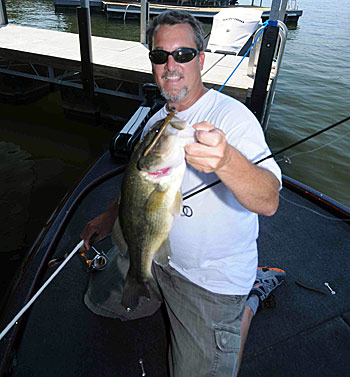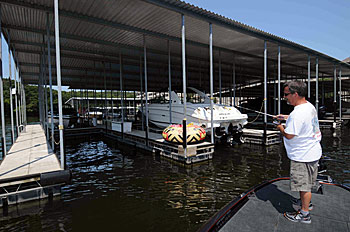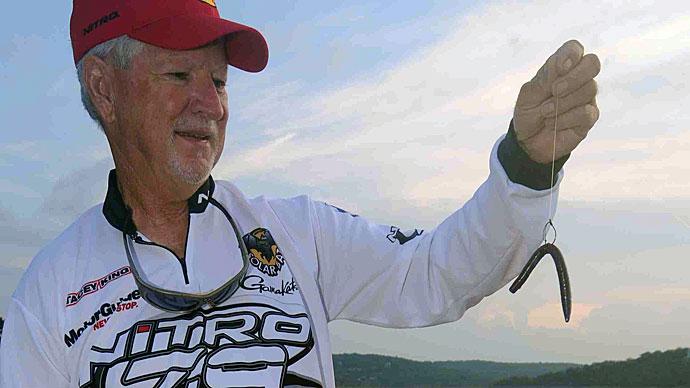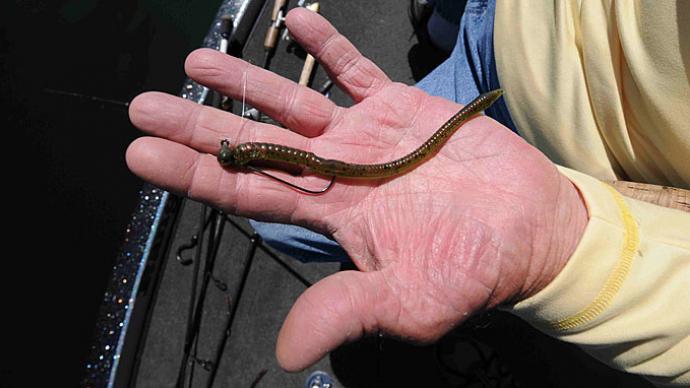
Fishing guides are under constant pressure to find ways for their clients to catch bass under adverse conditions.
Guide Steve Wilson has developed a sure-fire way for his clients to catch bass even during the heat of summertime. His technique is a spinoff of the finesse tactic he used in his younger days when he fished with a 4-inch Charlie Brewer Slider worm and 6-pound test line.
The tournament competitor and Lake of the Ozarks guide eventually graduated to fishing with baitcasting equipment and larger lures and started catching bigger bass but also less fish. While fishing tournaments in Tennessee in 2000, Wilson won an event with four quality bass, but he noticed the second-place finisher had caught three limits of bass that day. Wilson recalled he never caught three limits of bass even when practicing, so he asked the fellow who finished second what he was using. He showed Wilson his combination of a 1/16-ounce Buckeye Spot Remover jighead and a small finesse worm.
Four years later, Wilson was struggling to catch bass on Lake of the Ozarks one day when he decided to try the finesse tactic he discovered in Tennessee and proceeded to catch 20 keeper bass. He matched a 1/8-ounce Buckeye Spot Remover jighead with a green pumpkin Zoom Finesse Worm that he could fish on the bottom or swim it for suspended fish.
“I have caught bass all over the country with this technique,” Wilson says. He notes it is a “good last resort tactic” during a tournament when all else has failed, and he needs a keeper.
The tactic is especially effective on lakes loaded with boat docks where bass suspend under the docks. During the summertime, the docks provide shade and cooler water for fish. “There are all kinds of fish (baitfish, bluegill, and bass) under those docks,” Wilson says.
The Missouri guide prefers fishing the docks on bright sunny days because the sunshine positions the fish better. “When it is cloudy, everything is shady, and the fish tend to roam,” he said. “When you have a high, bright sun, the shade lines are more defined and are smaller. It might not be as comfortable to be out there in the heat of the day, but it makes the fish more predictable.” So he describes the ideal weather conditions for his finesse tactic as “not a cloud in the sky and pushing 100 degrees.”

Wilson starts in the morning fishing brush piles around the shallower private residential docks, but as the sun gets higher in the sky, he moves to the larger community or marina docks that produce more shade. These docks sit over 25 to 50 feet of water, but bass will be suspended 2 to 6 feet deep under the dock’s floatation. So Wilson keys on the shady side of the docks, boat wells, or corners serve as ambush points for bass.
Wilson starts his presentation by pitching his shaky head worm to a shady spot of the dock and letting it fall only 2 to 6 feet deep before reeling it in to make another pitch. “You catch more fish in a day because you are making more presentations (than someone who fishes the worm 20 feet deep),” Wilson says. He suggests you can fish the worm deeper and catch bigger bass, but you will catch fewer fish.
He employs a simple retrieve for fishing the worm around the docks. “You don’t have to do much with it,” Wilson says. “You just toss it in that shade and swim it through there.” He retrieves his finesse bait with a medium action 6-foot, 3-inch spinning rod and spinning reel (2000 model) filled with 8-pound Seaguar Red Label fluorocarbon line.
The Missouri guide watches his line for indications of a strike. If the line stops falling or starts moving sideways, he sets the hook because he knows a bass has taken the bait. Wilson also sets the hook if he feels extra weight on the line because there is usually nothing around the dock besides a fish that would make the line feel heavier.
“It’s not a hard technique to learn,” Wilson says. “I do it on guide trips all the time. It’s a great technique if you want to take your kid fishing or teach somebody how to catch fish.”
Wilson suggests it is hard to predict what size fish you will catch with his finesse technique. “You might pitch in there and catch an 8-inch Kentucky (spotted bass), then you might pitch in there and catch a 4-pounder,” he says. “You get a lot of bites, and you catch a lot of fish, but you also catch some quality fish that will surprise you.”
On one 8-hour guide trip this summer, Wilson’s clients caught two 6-pounders, two 4-pounders, and another 16 or more keepers fishing the finesse worm around the docks. “You can catch 50-plus fish a day,” he says. “So you better bring a lot of worms.
BassResource may receive a portion of revenues if you make a purchase using a link above.




